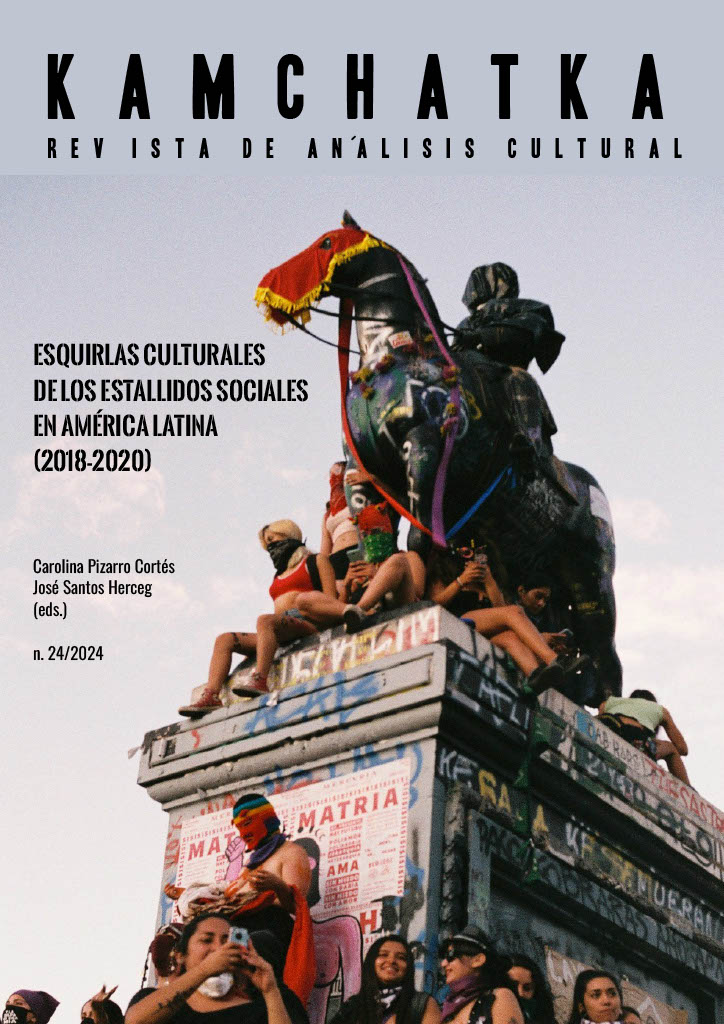Aerial views, archive and politics of the truth. The use of images in Tear Gas in Plaza de la Dignidad by Forensic Architecture
DOI:
https://doi.org/10.7203/KAM.24.27577Keywords:
Aerial Views, Digital Images, Archive, Visual Studies, Social Outbreak, Geopolitics Abstract
Abstract
This article analyzes the visual and discursive strategies used by the interdisciplinary collective Forensic Architecture (FA) in the development of the audiovisual material Gas Lacrimógeno en Plaza de la Dignidad (2020). This research sought to document the excessive use of chemical gas by the Carabineros de Chile against the protesting masses on the fringes of the 2019 social uprising. From the perspective of visual studies, the text focuses on the tracking, use and montage of images captured through surveillance devices such as drones and satellites, used by the AF to create a visual testimony. It proposes to analyze these images as a digital complex that combines documentation, archiving, and disembodied and machinic information, acting as a political cog in the production of truth by recording various forms of contemporary geopolitical conflict from the air.
 Downloads
Downloads
 References
References
Allen, J. (2010) “That eye, The sky”. Frieze: https://www.frieze.com/article/eye-sky
Blanco, J., Parente, D., Rodríguez, P., Vaccari, A., et al. (2015) “Cultura y Técnica”. Amar a las máquinas cultura y técnica en Gilbert Simondon. Prometeo Libros, pp. 19–33.
Bourriaud, N. et al. (2008) Heterocronías: Tiempo, Arte y Arqueologías del Presente. Murcia: Cendeac.
Bourriaud, N. y Mattoni, S. (2014) Postproducción: La Cultura Como Escenario, modos en que el arte reprograma El Mundo Contemporáneo. Buenos Aires: Adriana Hidalgo.
Burke, P. (2005) Visto y no visto: El Uso de la Imagen Como Documento Histórico. Barcelona: Critica.
Certeau, M. de, Giard, L. and Mayol, P. (2010) La invención de lo cotidiano. México, DF: Universidad Iberoamericana, Departamento de Historia.
Chamayou, G. (2016). Teoría del dron. Barcelona: Ned ediciones.
Cornago Bernal, O. (2016) “El concepto de dispositivo en la obra de Harum Farocki e Hito Steyerl”.
Crary, J. (2008). Las técnicas del observador: Visión Y Modernidad en el Siglo XIX. Cendeac.
Deleuze, Guilles and Guattari, F. (2010) “Tratado de nomadología: La máquina de guerra”. Mil mesetas: Capitalismo y esquizofrenia. Valencia, España: Pre-Textos, pp. 359–431.
Déotte, J. (2012). ¿Qué es un aparato estético?: Benjamín, Lyotard, Ranciére. Ediciones / metales pesados.
Didi-Huberman, G. et al. (2021) “El archivo arde”, in Las lenguas del archivo: Filologías para el siglo XXI. La Plata: Universidad Nacional de La Plata. Facultad de Humanidades y Ciencias de la Educación. (7), pp. 15–34. https://www.libros.fahce.unlp.edu.ar/
index.php/libros/catalog/book/174
Emmelhainz, I. (2015) “Conditions of visuality under the anthropocene and images of the anthropocene to come”, E-flux: https://www.e-flux.com/journal/63/60882/
conditions-of-visuality-under-the-anthropocene-and-images-of-the-anthropocene-to-come/
Farocki, H. et al. (2015) Desconfiar de las Imágenes. Buenos Aires: Caja Negra.
Forensic Architecture. Gas lacrimógeno en Plaza de la Dignidad. (2019). https://forensic-architecture.org/investigation/tear-gas-in-plaza-de-la-dignidad
Gómez-Moya, C. et al. (2012) “La de archivo es la primera condición”. Arte, Archivo y Tecnología. Providencia: Ediciones Universidad Finis Terrae, Dirección de Investigación y Publicaciones, pp. 27–46.
Groys, B. (2013) Antología. Traducido por S. Villa. México: COCOM.
Haraway, D. (1995). Ciencia, cyborgs y mujeres: La reinvención de la naturaleza. Madrid: Cátedra.
Heidegger, M. (2001). “La época de la imagen de mundo”. Caminos de Bosque. Madrid: Alianza Editorial.
Hensley, N. K. (2016). “Drone form: Word and image at the end of empire”. E-flux: https://www.e-flux.com/journal/72/60482/drone-form-word-and-image-at-the-end-of-empire/
Hernández, M. (2020) “Contratiempos del Arte Contemporáneo”. El arte a contratiempo. Akal, pp. 16–28.
Hui, Y. (2016). On the existence of digital objects. University of Minnesota Press.
Hui, Y. (2017) “¿Qué es un objeto digital?”. Virtualis, 8(15). doi: 10.2123/virtualis.v8i15.221.
Jamenson, F. and Golobuv (2003) “El fin de la temporalidad”. Chicago University Press, pp. 31–66.
Mbembe, A., & Beneduce, R. (2016). Necropolítica. Verona: Ombre Corte.
Medina, C. (2021). Cuando el gas deja de ser invisible, Maternar. https://muac.unam.mx/exposicion/sala10-forensic-architecture
Moxey, K., Aguirre, A. G. y Navarro, M. Á. H., (2015). El tiempo de lo visual: La imagen en la historia. Sans Soleil Ediciones.
Parks, L. (2005). Cultures in orbit: Satellite Technologies, global media and local practice.
Parks, L. (2009). “Digging into google earth: A critical analysis of 'crisis in Darfur'. Academia.edu: https://www.academia.edu/16426877/Digging_into_Google_Earth
_A_Critical_Analysis_of_Crisis_in_Darfur
Parks, L. (2015) “Orbital performers and satellite translators: Media art in the age of Ionospheric Exchange, Quarterly Review of Film and Video”. https://www.academia.edu/16426438/Orbital_Performers_and_Satellite_Translators_Media_Art_in_the_Age_of_Ionospheric_Exchange
Simondon, G. (2007). El Modo de Existencia de los objetos técnicos. Prometeo Libros.
Sofsky, W. (2006). Tratado sobre la violencia. Abada.
Stahl, R. (2013) “What the drone saw: the cultural optics of the unmanned war”, Australian Journal of International Affairs. https://www.tandfonline.com/doi/abs/10.1080/
2013.817526
Steyerl, H., Berardi, F. y Expósito, M. (2014c) Los condenados de la pantalla. Buenos Aires: Caja Negra.
Steyerl, H. (2003a). “Politics of truth”. Springerin. https://www.springerin.at/en/
/3/politik-der-wahrheit/
Steyerl, H. (2003b). “Documentarism as politics of truth”. Transversal texts. https://transversal.at/transversal/1003/steyerl/en
Steyerl, H. (2011). “In free fall: A thought experiment on Vertical Perspective”. E-flux: https://www.e-flux.com/journal/24/67860/in-free-fall-a-thought-experiment-on-vertical-perspective/.
Vaskes Santches, I. (n.d.). Posmodernidad Estética de Frederick Jameson: Pastiche y esquizofrenia. http://www.scielo.org.co/scielo.php?script=sci_arttext&pid=S0120-46882011000200003
Weizman, E. (2002) “Introduction to the politics of verticality”. openDemocracy: https://www.opendemocracy.net/en/article_801jsp/
Weizman, E. et al. (2020) Arquitectura forense: Violencia en el umbral de detectabilidad. Lugo: Bartlebooth.
Downloads
Published
How to Cite
-
Abstract1
-
Artículo PDF (Español)0
Issue
Section
License
Copyright (c) 2024 Carla Nicole Ayala Valdes

This work is licensed under a Creative Commons Attribution-NonCommercial 4.0 International License.
This journal provides an immediate free access to the content on the principle that freely make investigation available to the public, which promotes an increased global knowledge exchange.
Unless otherwise indicated, texts published in this journal are under the license Attribution-NonComercial 4.0 by Creative Commons. These texts may be copied, distributed and publicly communicated whenever the publication’s author and title are quoted and whenever they are not used for commercial purposes. In any case, intellectual property of the articles and its potential economic rights entirely belong to its authors.
The full license can be consulted on https://creativecommons.org/licenses/by-nc/4.0/. We encourage authors to disseminate papers published in Kamchatka. Journal of cultural analysis electronically, in institutional digital repository or in their websites.





